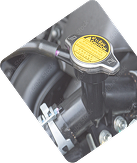
Customer overview
Henkel is the world leader in adhesives, sealants, and functional coatings for consumers, craftsmen, and industrial applications.
Labels that couldn’t withstand cryogenic storage
When CleanMark first approached Henkel with a cold call, they didn’t express any immediate interest in doing business together. But over the course of that first conversation, the CleanMark salesperson was able to pique their interest in our capabilities. Henkel eventually described one very specific problem they were having with labels used in cryogenics that CleanMark might be able to help them with.
Henkel was making a specialty adhesive in the United States for bonding semiconductors. The adhesive was temperature sensitive. It required refrigerated storage and, when shipped, needed to be packed in dry ice. Due to the low temperatures, the labels that were affixed to the adhesive’s syringe-like applicators were falling off in transit. Not being marked properly upon delivery was causing a major problem. Henkel needed a label they could count on to survive the intense temperatures.
Labels that stay put, even in cryogenic storage
Our first attempt was to use existing freezer labels, but testing proved that they would not perform well considering the time and distance requirements of Henkel’s global shipping. CleanMark COO Lane Kagey contacted a chemist he knew and inquired about developing an adhesive to stand up to the low temperatures. The chemist explained that when adhesives get really cold, they get brittle. An adhesive could be produced to withstand the cold, but when re-exposed to room temperature, it would become very fluid. CleanMark’s challenge was to develop an adhesive that could perform at dry ice temperatures, while also maintaining its integrity at room temperature.
A couple of different alternative chemistries were developed and tested, and finally CleanMark chose one that met the stringent cryogenic storage requirements with one condition: both the raw material and the finished stock had to be kept in an air-conditioned room — a warehouse was too warm. The proposal for the new product went to Henkel. They tested it, used it for shipping their adhesives overseas, and the performance of the labels proved exceptional.
Cryogenic storage labels for diverse applications

The process not only solidified a technique for producing high-performance cryogenic storage labels, but also a mutually beneficial relationship with a world leader in adhesive technologies — a solid partnership that remains vibrant today. Based on the trust that came out of the problem-solving dynamic, Henkel continues to buy products from CleanMark. The process also gave Henkel the confidence to turn to us whenever they set out to explore new technologies.
Another byproduct of the work done for Henkel has been CleanMark’s advancements in label technology used in cryogenic storage. Investing in testing equipment to work on cold storage labels, we started conducting tests with liquid nitrogen and creating labels and adhesives that hold up to temperatures between -320° F and -346° F. From that testing, CleanMark was able to perfect labels that can be used in a variety of cryogenic storage applications.
Looking for more detailed information?
Explore case studies, articles, guides and more in our extensive library of labeling resources.

Harness the power of the CleanMark LabelBuilder

What does the Food Traceability Rule mean for your labeling procedures?

CleanMark Labels: 40 years solving the impossible
Stay up to date on labeling advances in your industry
From white papers to industry surveys and ebooks, we’ll make sure you’re informed about the latest technology that can make your operations more efficient and less stressful.


















